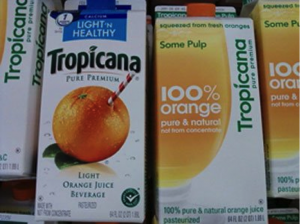This blog post is in response to Lucy Stephenson’s blog post regarding “The Tropicana Effect.”
Brand logos and symbols vividly distinguish brands from one another. A popular brand is usually associated with an effective design that is easily distinguishable from others.
When PepsiCo changed Tropicana’s “public face” and completely redesigned its packaging, instant drops in sales occurred in less than two months resulting to a 20% loss.
In COM 101 we dedicated a class to consumer behaviour and marketing research, which completely ties in with this. After learning about the consumer decision funnel and consumer feedback loop, it is evident that marketing may not entirely impact a business’ profit but has some influence upon it. The total 20% loss may have not all been because of the rebranding as other factors may have affected a consumer’s decision when purchasing a good. However, in this case, I believe a significant proportion of the percentage lost was due to the dramatic change.
This comes to show what a difference a change can make if it’s not planned out right. When rebranding, it is important to experiment and ease people into it because people will get confused by the sudden change. This ultimately destructs the trust once built between the consumer and company.
Maintaining trust is one of the most important things a business can do. After a consumer purchases a product or service, the consumer builds on experience to inform the next decision journey. If satisfaction is obtained, consumers will have a positive word of mouth and will commit to regular shopping habits. However, if a company plays its cards wrong, everything created would go to waste.
Lucy mentioned a good point in her blog. She pointed out that the reason why previous loyal customers may have betrayed the brand, turning to alternate brands such as Minute Maid, is possibly because there was no indication of a familiar characteristic in the new design, so consumers probably related that with what potentially was offered inside. In the eyes of a consumer, a change in packaging could be a change in quality. Therefore, I strongly agree with Lucy’s theory.
After comparing Tropicana’s two designs, I noticed a few additional issues that could have contributed to its poor performance also. The new design didn’t contain any similarities to the previous one. By removing its noticeable image of an orange with a straw in it and changing its brand name’s font and size, as well as rotating it 90 degrees, people probably had troubles identifying what was once one of their favourite drinks. Usually when drastic differences like this are made, people will superficially come to the conclusion that that product may instead be a knockoff or store brand. Also, children impact consumer behaviour as well since they greatly affect their parents’ purchases. If they couldn’t recognize the brand, they would not have made an effort to ask for it.
People usually associate change with a good thing, but if there is nothing to fix then maybe it is better not to change anything at all. Evidently, this was a lesson well learned by PepsiCo where they almost made the crucial mistake of permanently giving away their “calling card.”
Source:
http://adage.com/article/news/tropicana-line-s-sales-plunge-20-post-rebranding/135735/
